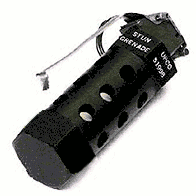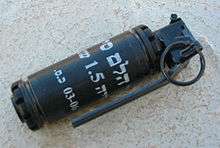Stun grenade
| Stun grenade | |
|---|---|
 M84 stun grenade | |
| Type | Non-lethal explosive device |

A stun grenade, also known as a flash grenade, flashbang or sound bomb,[1] is a non-lethal explosive device used to temporarily disorient an enemy's senses. It is designed to produce a blinding flash of light and an intensely loud "bang" of greater than 170 decibels (dB)[2] without causing permanent injury. It was first used by the British Army's SAS in the late 1970s.[3]
The flash produced momentarily activates all photoreceptor cells in the eye, making vision impossible for approximately five seconds, until the eye restores itself to its normal, unstimulated state. An afterimage will also be visible for a considerable time, impairing the victim's ability to aim with precision. The loud blast is meant to cause temporary loss of hearing, and also disturbs the fluid in the ear, causing loss of balance.
The concussive blast of the detonation can still injure, and the heat created can ignite flammable materials such as fuel. The fires that occurred during the Iranian Embassy siege in London were caused by stun grenades.
Construction
Unlike a fragmentation grenade, stun grenades are constructed with a casing made to remain intact during detonation, containing most of its explosive force and avoiding shrapnel injuries, while having large circular cutouts to allow the light and sound of the explosion through. The filler consists of a pyrotechnic metal-oxidant mix of magnesium or aluminium, and an oxidizer such as ammonium perchlorate or potassium nitrate.
Lethality of stun grenades
Although stun grenades are usually designed to be non-lethal, several injuries and deaths have been officially attributed to their use. These include the following:
- In 1989, police in Minneapolis, Minnesota, conducted a drug raid at the home of an elderly couple, Lloyd Smalley and Lillian Weiss, after receiving inaccurate information from an informant. The flashbang grenades police used in the raid set the home on fire. Police said they were certain no one was inside, and so, at first, made no attempt at rescue. Smalley and Weiss died of smoke inhalation.[4][5][6][7][8]
- In May 2003, a woman named Alberta Spruill died from a heart attack after a police team detonated a stun grenade at her residence in Harlem, New York while looking for a drug dealer who was already in police custody. Her family eventually won a $1.6 million civil suit against the city.[9]
- In February 2010, police in Minneapolis, Minnesota, raided the apartment of Rickia Russell looking for drugs. While Russell was eating dinner with her boyfriend, police threw a flashbang grenade after breaching the door. The exploding flashbang gave Rickia 3rd degree burns on both calves, and burns to her head. No drugs were found in Russell's apartment and the Minneapolis City Council agreed to pay $1 million in damages.[10]
- In January 2011, a California man named Rogelio Serrato died of smoke inhalation after a flashbang grenade launched by a police SWAT team ignited a fire in his home.[11] The man was believed to have been hiding in the attic when the fire broke out.[12]
- In February 2011, a North Carolina SWAT police officer was injured at his home when a stun grenade accidentally detonated while he was attempting to secure his equipment. He underwent emergency surgery, but later died of his injuries.
- In January 2014, a man was severely injured during rioting caused by the 2014 Ukrainian revolution after he attempted to pick up a live, undetonated stun grenade. The grenade detonated seconds before he could reach it. The explosion caused damage to his right hand and arm, leading to the loss of most of his fingers, as well as heavy blood loss. As of February 2014, the man's condition is unknown.[13] However, a video of it has been uploaded to LiveLeak.[14]
- On May 28, 2014, a 19-month-old baby boy's face was severely burned and mutilated when a stun grenade was thrown into his playpen by a SWAT team looking for drugs in a Cornelia, Georgia home. The baby survived with facial disfigurement.[15]
- On August 3, 2014, a Macedonian fan of the FK Vardar football team was seriously injured during a football match after trying to throw a stun grenade used by police when a fight between the police and the fans broke out in the stands of Stadion Tumbe Kafe stadium in Bitola. The grenade exploded in his hand causing him to lose two fingers and suffer severe damage to the structure of his arm.[16]
- On October 26, 2014, Rémi Fraisse died instantly after being hit in the back by a stun grenade during protests against the construction of the Sivens Dam in southern France.[17]
See also
References
- ↑ "Drugs raid recovers tonnes of cocaine and marijuana in Chile". September 3, 2014.
- ↑ "Measurement of Exposure to Impulsive Noise at Indoor and Outdoor Firing Ranges during Tactical Training Exercises" (PDF). Retrieved 2013-08-25.
- ↑ "SAS - Weapons - Flash Bang | Stun Grenade". Eliteukforces.info. Retrieved 2013-05-29.
- ↑ Governmentabuse.info
- ↑ Karren Mills, "City Image Tarnished By Allegations of Police Racism," Associated Press, March 21, 1989. Google News
- ↑ David Chanen, "Police device used in search is considered safe, official says," Minneapolis Star Tribune, March 17, 2000, p. 7B. Highbeam.com
- ↑ The case is also cited in “Botched Police Raids not so rare” Google News
- ↑ The case is also cited in “Botched raid costs Minneapolis $1 million”, Star Tribune December 9, 2011 Star Tribune
- ↑ Shaila K. Dewan (2003-10-29). "City to Pay $1.6 Million in Fatal, Mistaken Raid". The New York Times. Retrieved 2013-05-29.
- ↑ Carlyle, Erin (2011-12-10). "Rickia Russell wins $1 million police brutality settlement after burns from flashbang grenade". City Pages. Retrieved 2014-10-07.
- ↑ Gratz, Matt (2011-07-26). "California SWAT burns innocent man to death with flash-bang stun grenade". Political Fail Blog. Retrieved 2013-05-29.
- ↑ "Rogelio Serrato died in a fire during the Jan. 5 raid in the 200 block of San Antonio Drive". Fugitive.com. Retrieved 2013-05-29.
- ↑ the aliens are here bro (2014-01-20). "LiveLeak - The moment man lost his hand to a stun grenade.". LiveLeak.com. Retrieved 2014-02-24.
- ↑ Liveleak.com
- ↑ "Toddler critically injured by 'flash bang' during police search". 2014-05-29. Retrieved 2014-05-30.
- ↑ "Macedonia: Fan nearly lost hand after police throw grenade in the away sector.". 2014-08-03. Retrieved 2014-08-03.
- ↑ French Socialists and Greens at odds following death of Sivens dam protester The Guardian, 28 October 2014
External links
- FM 3-23.30 "Grenades and Pyrotechnic Signals". globalsecurity.org, 1 September 2000. Ch. 1, Sec. 10. "Stun Hand Grenades". Retrieved on 26 May 2011.